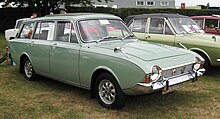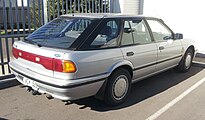Ford Corsair
The nameFord Corsairwas used both for a car produced byFord of Britainbetween 1963 and 1970, and for an unrelatedNissan-based automobile marketed byFord Australiabetween 1989 and 1992.
Ford Consul Corsair (1963–1965), Ford Corsair V4 (1965–1970) – Britain
[edit]| Ford Consul Corsair Ford Corsair V4 | |
|---|---|
 | |
| Overview | |
| Manufacturer | Ford UK |
| Production | 1963–1970 |
| Assembly | Halewood,England (1964–1969) Dagenham,England (1969–1970)[1] |
| Body and chassis | |
| Body style | 4-doorsaloon 2-doorsaloon 2-doorconvertible 2-doorcabriolet 5-doorestate car |
| Layout | Front-engine, rear-wheel-drive |
| Related | Ford Cortina Mark 1 |
| Powertrain | |
| Engine | |
| Transmission | 4-speedmanual |
| Dimensions | |
| Wheelbase | 101.0 in (2,565 mm) |
| Length | 176.75 in (4,489 mm) |
| Width | 63.5 in (1,613 mm) |
| Height | 55.5 in (1,410 mm) |
| Kerb weight | 2,194 lb (995 kg) |
| Chronology | |
| Successor | Ford Cortina Mark 3 |
TheFord Consul Corsair(later known simply as theFord Corsair), manufactured byFord UK,is amidsized carthat was introduced at theLondon Motor Showin October 1963[2]and available as either asaloonorestatefrom 1964 until 1970. Also, aconvertibleversion was built byCrayford Engineering,which is now very rare and highly sought-after as a classic. Two-door Corsair saloons are also rare, being built only to order in the UK, although two-doors were produced in quantity for some export markets. The Consul Corsair S was an export-only model with a two-door Deluxe body and 1500GT engine, sold in Austria and Sweden, and also in South Africa as the Corsair 83. Only one example of the fleet model, the Consul Corsair Standard, is known to survive. Unlike the Ford Cortina which had five versions (Mks), or the Ford Capri which had face-lifts, the entire production run of the Ford Corsair was a consistent Mk 1, with the body remaining the same, and the design changes being confined to the interior, engine, and mechanicals.[citation needed]


The Corsair was designed by the same team as the Mark 1Cortina,with Roy Brown Jr. overseeing the styling by Charles Thompson, and Fred Hart in charge of the engineering. Replacing theConsul Classicrange, it was essentially a long wheelbase re-skinned Cortina with extra soundproofing and more comfortable seating for high speed long-distance driving. The windscreen and side windows are shared with the Cortina, the mechanical components with the Cortina GT, and the body's internal panels are basically similar. The Corsair had unusual and quite bold styling for its day, with a sharp horizontal V-shaped crease at the very front of the car into which round headlights were inset. This gave the car a relatively aerodynamic shape; the top speed of the Corsair 1500 was higher than the equivalent Cortina 1500 even though the Corsair was slightly larger and heavier. The jet-like styling extended to the rear where sharply pointed vertical light clusters hinted at fins, recalling the Ford Consul Mark 2. The overall styling theme was shared with the early 1960sFord Thunderbird;both cars were inspired by Uwe Bahnsen's design for the 1960Ford Taunus P3,but the Corsair was an economical medium-sized motorway cruiser with smooth light-weight bodywork, and very like the Taunus in concept.
In 1964 Tony Brookes, with his twin brother as one of the drivers, and a group of friends captured 15 International class G World endurance records at Monza in Italy with a Corsair 1500 GT. (Monza Yearbook 1965)


The Corsair Deluxe was initially offered with the larger 60 bhp (45 kW), single-carburettor, 1.5 LKent enginethat was also used in the smallerCortina,and the Corsair GT came with the same 78 bhp (58 kW), 1.5-litre engine as the Cortina GT. The car received positive reviews from motoring journalists, with some reservations about the dash layout and the closeness of the steering wheel to the driver. Although the 1963-65 Corsair range outsold the Classic, the car was not a best-seller like the Cortina, but given the low development costs it was presumed to be profitable for Ford. The range was revised in September 1965, gaining a better dashboard and interior ventilation, but adopting newFord Essex V4 engineswhich were rough at idle and coarse on the road.[citation needed]The Essex engine was made in 1.7 L (1,663 cc) capacity for the Corsair V4 Deluxe, and a 2.0-litre version with high fuel consumption and disappointing performance was installed in the Corsair V4 GT. One marketing tagline for the V4 models was "The Car That Is Seen But Not Heard", which was a real stretch of the ad man's puff, given the inherent characteristics of the engine. The other tag was "I've got a V in my bonnet". These V4 engined cars were poorly regarded by the public, and sales began to taper off. In January 1967 a much improved version of the 2.0 L engine was released, and in April 1967 the problematic V4 GT was replaced by the 2000E model. A 3.0-litre conversion using theFord Essex V6 enginewas one of the options available via Crayford Engineering.
| Consul Corsair 1500 (1963-1965) | Units |
|---|---|
| Corsair 1500 Standard 2 Door | 355
|
| Corsair 1500 Standard 4 Door | 953
|
| Corsair 1500 Deluxe 2 Door | 33,352
|
| Corsair 1500 Deluxe 4 Door | 103,094
|
| Corsair 1500 GT 2 Door | 6,610
|
| Corsair 1500 GT 4 Door | 15,247
|
| Total Corsair 1500 (1963-1965) | 159,951
|
| Corsair V4 (1965-1970) | Units |
|---|---|
| Corsair V4 Deluxe 2 Door | 6,450
|
| Corsair V4 Deluxe 4 Door | 118,065
|
| Corsair V4 GT 2 Door | 1,534
|
| Corsair V4 GT 4 Door | 12,589
|
| Corsair V4 2000E 4 Door | 31,566
|
| Corsair V4 Estate | 899
|
| Corsair V4 Estate 2000GT | 40
|
| Corsair V4 Estate 2000E | 1
|
| Total Corsair V4 (1965-1970) | 171,144
|
| Total Ford Corsair production | 331,095
|
Two-door Corsairs were almost all LHD cars,
destined for Europe/export.
An estate car byAbbottwas added to the range on the eve of theGeneva Motor Showin March 1966,[5]and in 1967, the Corsair underwent the Executive treatment like its smaller Cortina sibling, resulting in the 2000E model with dechromed flanks, which necessitated non-styled-in door handles, special wheel trims, reversing lights, a vinyl roof, and upgraded cabin fittings including a polished wood dashboard. The 2000E, priced at £1,008 in 1967, was positioned as a cut price alternative to theRover 2000,the introduction of which had effectively defined a new market segment for four cylinder executive sedans in the UK three years earlier: the Corsair 2000E comfortably undercut the £1,357 Rover 2000 and the £1,047Humber Sceptre.[6]
A five-seater convertible and a four-seater cabriolet conversion were available viaCrayford Engineering.Only 18 Cabriolets were built, using technology from theKarl Deutsch GmbHin Germany. Only four are known to survive.
The Corsair's performance was good for a car of its type and period, with a top speed in its later 2.0 L V4 version of 110 miles per hour (180 km/h) as measured by the speedometer,[7]thanks to the progressive 28/36mm twin-choke Weber downdraught carburettor.
The Corsair was replaced by the Mk 3 Cortina in 1970, when the enlarged Cortina became Ford's midsized car, and a new smaller model, theEscort,had already filled in the size below. The newFord Capritook on the performance and sporty aspirations of the company.
Over its six-year production, 310,000 Corsairs were built, of which about 600 are thought to survive in the UK as of 2019. Conversely, of the 200 convertibles built, around 75 have survived.[citation needed]
The Corsair was also manufactured by Ford in Ireland and South Africa. A small number of Corsairs were exported to Australia and New Zealand.
Ford Corsair (UA, Australia)
[edit]| Ford Corsair (UA) | |
|---|---|
 Ford Corsair (UA) Ghia sedan | |
| Overview | |
| Manufacturer | Nissan Australia |
| Production | 1989–1992 |
| Assembly | Clayton,Australia |
| Body and chassis | |
| Body style | 4-doorsedan 5-doorhatchback |
| Layout | Front-engine, front-wheel-drive |
| Related | Nissan Pintara (U12) |
| Powertrain | |
| Engine | 1,974 ccCA20EI4 2,389 ccKA24EI4 |
| Chronology | |
| Predecessor | Ford Telstar (AT/AV) |
| Successor | Ford Telstar (AX/AY) |
Between 1989 and 1992, the Ford Corsair name was used byFord Australiafor abadge-engineeredversion of theNissan Pintara(a version of theBluebird).[8]
Known during development as 'ProjectMatilda',[9]the Corsair was produced under a model-sharing scheme known as theButton Plan.It was offered as a four-doorsedanand as a five-doorliftback,in GL and Ghia trim levels with 2.0 L (CA20E) and 2.4 L (KA24E) four-cylinder engines.
The Corsair was intended to replace theMazda 626-basedFord Telstar,which was imported from Japan. The two were sold side by side in the Australian Ford range, with the Telstar only available as the high-performance TX5 hatchback. However, it proved less popular than the Telstar had been, losing sales dramatically during 1991.[10]
When Nissan closed its Australian plant in 1992, the Corsair was discontinued and the importedTelstaronce again became Ford's main offering in the midsized segment, until being replaced by theMondeoin 1995.
-
Sedan
-
Hatchback
Edsel Corsair
[edit]
The unrelated Edsel Corsair was produced by the former Mercury-Edsel-Lincoln Division of theFord Motor Companyin the United States and sold under itsEdselmarque in 1958 and 1959.
References
[edit]- ^"News and Views: Corsairs to Dagenham".Autocar.Vol. 131, no. 3844. 7 August 1969. p. 13.
- ^"Used Cars on test: 1964 Ford Corsair de Luxe".Autocar.Vol. 126 (nbr 3717). 11 May 1967. pp. 40–41.
- ^"Cars stand by stand: coachwork: Crayford Auto Developments [stand]173".Autocar.Vol. 125 (nbr 3688). 21 October 1966. p. 844.
- ^Ford Corsair Owners' Club Records at August 2018
- ^"Corsair GT Estate Car".Autocar.Vol. 124 (nbr 3656). 11 March 1966. p. 526.
- ^"Ford Corsair 2000E road test".Autocar.Vol. 126 (nbr3705). 15 February 1967. pp. 35–37.
- ^Measured at 100 miles per hour (160 km/h) by Motoring Which?[clarification needed]April 1968 issue
- ^The Bulletin,Volumes 114-115, 1993, page 70
- ^Information, Opportunism and Economic Coordination,Peter E. Earl, Edward Elgar Publishing, 2002, page 28
- ^International Motor Business,Volumes 149-152, Economist Intelligence Unit, 1992, page 68-80


